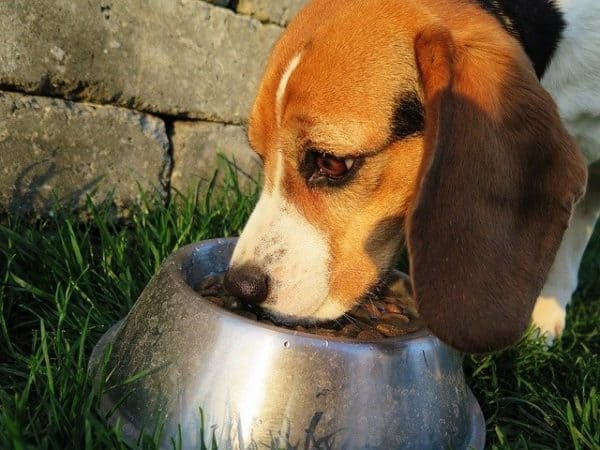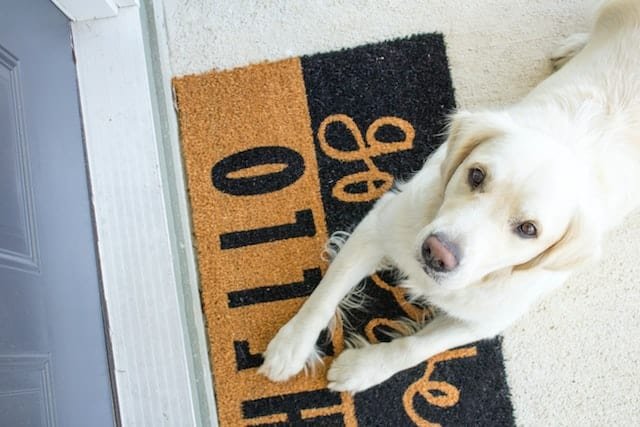17 Easy Ways To Get A Picky Dog To Eat

There are some affiliate links below, but they are all products I highly recommend. For more info, view my disclosure here.
Do you have a picky dog? Some dogs will eat whatever food is put down for them, and will be perfectly content with more of the same. They eat every snack they are offered, every treat, and will even pout desperately for some human food.
These are the dogs that can easily put on weight and should have managed portions. Which totally describes our Roxy and was how Ginger always was!
Other dogs are really picky about what they are prepared to eat. Tasty treats are ignored, snacks rejected and the dog looks at its dinner with a baleful eye and then looks at you accusingly. This…is Rico.
If the problem is a new one – if your dog normally eats its food happily and suddenly becomes picky – then the first step is to see your veterinarian.
There are several medical issues that can lead to a dog becoming picky about food. If there is a medical problem, then your veterinarian will prescribe a course of treatment and hopefully the problem will be solved. If there is no medical reason for the newly developed pickiness, then you will have to encourage your dog back to eating properly.
In this article we are going to suggest a few methods of approaching picky eating that have worked for other dog owners. You will need patience and determination, but pickiness can be overcome.
We cannot stress strongly enough the importance of taking your dog to your veterinarian if you notice changes in your dog’s behaviour, any signs that they might be in pain, or if there is noticeable weight loss. Getting a clean bill of health will put your mind at rest. It’s good to know that you can tackle the issue of picky eating in different ways.
What Medical Issues Can Cause Picky Eating?
Medical reasons for picky eating might include:
- Dental problems like bad teeth or gum disease.
- Allergies. Some dogs do suffer from allergic reactions and will avoid food that they know upsets them. Dogs are not stupid and know when something is wrong!
- Pain. Your dog might be suffering from arthritis or cancer and copes with the pain by not eating properly.
- Infections. Your dog may just be feeling unwell, and off their food. Think about the way humans act when they feel unwell. Dogs do the same.
- Fleas or worms. Your dog might be feeling irritated by a flea infestation or worms. Your veterinarian can test for either of these and recommend the appropriate treatment.
- Side effects. Sometimes a dog will suffer side effects from a vaccination or medicine.
Tackling Picky Eating
Once all possible medical reasons have been investigated and dismissed then it is time to tackle the issue of picky eating. Here are some suggestions as to how to approach the problem:
1. Take The Uneaten Meal Away
Put your dog’s dinner down as usual. Use their usual bowl and follow your normal routine. Then leave your dog to eat. If they walk away leaving a bowl of uneaten food lift the bowl up and put it aside. Give your dog about 15 minutes to eat the food before removing it.
The next day present your dog with food again. Do not give them the same food they rejected the day before. Make a fresh bowl of food and try again. If your dog rejects the food again, take it away after 15 minutes and then follow the same routine.
Your dog should be getting hungry by now. It is likely that on the third attempt at giving them food they will eat. Dogs won’t risk starving. Your dog will also begin to realize that there is no other choice – it’s this food or nothing.
Now, you know your dog best, and for some dogs, this may not work well. When Rico doesn’t eat, he tends to get a little pukey and anxious, so we prefer to use the following options to get him to eat.
2. Try Tastier Food
Sometimes your dog will want to show you that they are bored with their food or that they don’t like the taste. Refusing the food is the only way they have of telling you. They just hope you will understand!
If you have been feeding a meaty flavor food try switching to a quite different flavor like fish. Don’t just swap over to another similar meaty flavor. Some fish flavor dog foods can smell quite strongly so beware.
Avoid frequent switches in flavor. Your dog might become more picky if he thinks there is a selection of flavors available.
You can also try making your own homemade dog food! It’s super easy and both Roxy and Rico LOVE it. I make a big batch and sometimes add it to their existing food.
It’s comforting to know that I know exactly what goes into it, the food is healthy, and they both love it and happily eat it! Get the delicious dog food recipe here!
3. Change Brands
Flavors from different brands will taste differently. This might seem obvious, but even a slight change in flavor could be enough to satisfy your dog’s needs. Remember that cheaper brands are not always worse for flavor!
Although frequent switching of flavors can have consequences like upset tummies, it might be necessary to try a few new brands and flavors just to find out what your dog prefers to eat.
4. Switch Slowly to a Different Flavor
Don’t rush to change flavors. You are more likely to have success if you approach the whole process slowly. Gradually introduce a new flavor by mixing a small amount with your dog’s existing food. Increase the amount of the new food each time you feed until you are giving them just the new food.

5. Use a Topper
Sometimes adding a topper to your picky dog’s food will interest them enough to get them to eat the whole meal. Commercially available toppers come as broths, sauces, dusts, or a few spoonfuls of another dog food.
We were recently sent a sample of Trudog Boost Me Freeze-Dried Raw Topper and Rico LOVED it! it’s packed with nutrients and he loved the smell, so he happily ate his food with it sprinkled in.
Fish oil can also make a meal tastier and more enticing. Fish oil contains Omega 3 which has additional health benefits. Take a look at the benefits of fish oil here!
6. Switch Dry or Wet Food
If you normally give your dog dry dog food like kibble, switch to a wet food for a few meals to see how your dog reacts. Similarly, if you use a wet food switch to dry for a short time. A mix of both sometimes works as an alternative to either types of food.

7. Increase the Exercise Your Dog Gets
It may be that your dog is not getting enough exercise to build up a healthy appetite. Some breeds of dog thrive on lots of exercise and you should ensure that they get enough. For some dogs just walking is not enough. They need to be running, chasing and exploring to make them hungry. Once they are hungry they will eat whatever food you put down for them.
Feed your dog right after their exercise. They will be hungry and ready to eat. They will also be tired and will sleep for a while too.
8. Don’t Overfeed Your Dog
It is easy to give a dog more food than it actually needs. Calculate how much food your dog should be getting at each meal – this depends on breed, size, amount of exercise, and type of food. Do not be tempted to give more than the correct amount.
9. Avoid Giving Human Food As Treats
Do not be tempted to give bits of your own meal to your dog. This can lead to them rejecting their food and hoping for some of yours instead.
10. Only Give A Few Dog Treats
On the subject of treats, most dogs love a treat. If you are in the habit of giving your dog treats – we mean dog treats – then cut back or leave them out for a while. Your dog’s pickiness will be made worse if they think they can get a treat instead of their own dinner.
11. Raise The Level Of The Bowl
Some senior dogs find bending down to eat hard due to stiffness or problems with swallowing. Place the bowl on a raised surface – or use a special eating unit created for senior dogs – and hopefully that will make a difference.
12. Keep To A Feeding Routine
If your dog has become used to a routine and you change it for some reason they might be put off. Keep to the same, established routine if at all possible. Dogs do like routine as it makes them feel safe and secure.
13. Keep it Fresh
Your dog’s food should be served fresh and leftover food should be disposed of, not served again. Bowls need to be clean for each meal. Picky dogs will be put off if their bowl smells odd or the food is drying out from being left for a while.
14. Give Your Dog Space To Eat
Ideally your dog should be able to eat in the same place each time. Create an area, perhaps in your kitchen, where your dog has its water and its food bowl. At mealtimes, ensure that your dog is not disturbed or distracted.
A picky dog will react best when fed in its own special area. Using a place in the kitchen means that spills can be cleaned up easily.
15. Warm the Food
Warming your dog’s food will help to release some of the flavor and make it more appetizing. Wet food can be microwaved – but don’t make it too hot. Warm is fine! Kibble can have warm water added or even some warm salt-free broth or stock.
16. Prepare the Food Away From Your Dog
It is really easy to put your dog’s food into its bowl on the floor right in front of them. But try preparing the food up on the kitchen surface so they can’t see what you are doing. Doing it slowly and adding in fun stuff like fish oil can increase their anticipation.

17. Work and Play
If your dog has to work for their dinner, they might be more inclined to eat it. The work they have to do will be in the form of play. Put food in a dinner toy so your dog has to figure out how to get it out before they can eat it. Heap praise on your dog when they do it properly so they link praise with success.
Snuffle mats and feeding toys add excitement and interest to feeding time, although using them will involve you in quite a bit of work. You might be able to invent a few food-seeking games to encourage your dog to hunt out treats.
We’re huge fans of dog puzzles in this house. Rico’s favorite is the Lucky Slot Dog Puzzle. We’ll put small kibble in it and he happily eats the same food he often rejects when it’s in the bowl. He’s our sweetly special boy!







